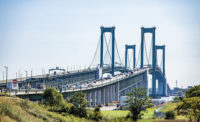Highway/Bridge Best Project - Bay Bridge

PHOTO COURTESY OF AMMANN & WHITNEY

PHOTO COURTESY OF AMMANN & WHITNEY

PHOTO COURTESY OF AMMANN & WHITNEY



Rewrapping and Dehumidification of the Main Cables and Anchorages of the Bay Bridge
Annapolis, Md.
Best Project
Owner Maryland Transportation Authority
Lead Design Firm Ammann & Whitney
General Contractor Kiewit Infrastructure Co.
Civil Engineer Ammann & Whitney
Structural Engineer Ammann & Whitney
MEP Engineer AECOM
Engineering T.Y. Lin International Group
Engineering HNTB
A project that the team claims is the first of its kind in North America, aimed to dehumidify and rewrap the main cables and anchorages of Maryland’s William Preston Lane Jr. Memorial Bridges—familiarly known as the Chesapeake Bay Bridge—to halt corrosion and extend the dual-span structure’s working life. The $43-million project got underway in September 2012 and was completed three years later, on time and on budget.
Although wire corrosion cannot be reversed, the dehumidification aims to inhibit it in the suspension bridge’s cables. When relative humidity is 40% or less within a cable, corrosion is stopped, which extends the bridge’s service life. Dehumidification can be installed at a reasonable cost with minimal impact to travelers, according to the project submission.
Water seepage was removed by running injection and exhaust sleeves along the cables. Dehumidified air is supplied from plant rooms within the anchorages. The system continues to operate and is controlled and monitored remotely by a supervisory control and data system. The system continuously logs relative humidity, temperature, flow and pressure in the cables, as well as plant-room conditions.
Testing the rewrapping and sealing methods for the main cable as well as the effectiveness of the selected materials proved challenging. Extensive shop trials provided training and mastering of the techniques of main cable wrapping, band caulking and testing the air injection and exhaust sleeves.
A pressurized test rig was used to test installation practices and materials. Once fully wrapped and sealed, the rig was pressurized to gauge air leakage, measured over a three-hour period. Soapy water was applied to the wrapping and sealing to identify leak points. The team says it effectively practiced these methods in the shop and held two field tests to ensure smooth transition from the shop to the field.
The five main firms on the design-build project maintained an open dialogue throughout the job, serving as a check-and-balance system for each other, according to the project submission. The team also said that a commitment to partnering helped it overcome project challenges.
To provide safe access to the bridge and maintain traffic below, the team worked together to design a walkway to provide fall and dropped-object protection as well as continuous safe access to the cables. Project staff and materials moved to the work areas by water to a stair tower, reducing lane closures on the heavily traveled bridge.
The team credits its partnering efforts for meeting the project’s schedule and budget. The project was awarded the 2016 Maryland Quality Initiative Award of Excellence for partnering success.






